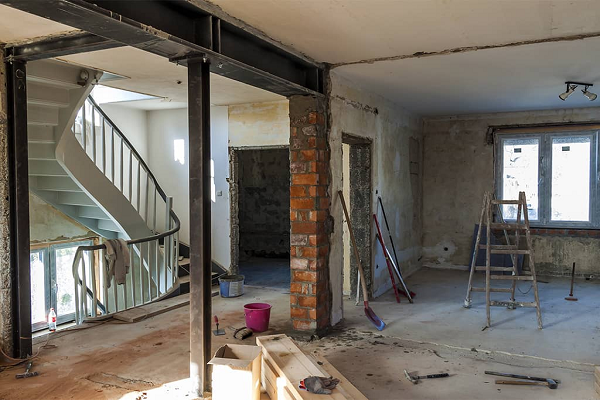News
Third Quarter Bridging Loan Transactions Hit New Record High
New data from Bridging Trends suggests that in spite of the year’s first quarterly interest rate increase, total bridging activity has once again reached a new record high. The impressive figures from Q3 indicate total bridging loan transactions of £214.7 million for the quarter, up a huge 20% on Q2 (£178.4 million).
This is the best quarterly performance for the UK’s bridging sector since Bridging Trends began monitoring the sector and reporting on combined market activity in 2015. The figures are even more impressive when taking into account the year’s first (albeit minor) increase in average bridging loan interest rates.
Having stood at 0.69% in Q2, the average interest rate on a bridging loan issued in Q3 came out at 0.73%.
Chain break prevention: The new top use for bridging finance
There was also a significant shift in borrower spending patterns in Q3, bucking the trend of several consecutive prior months. Chain break prevention topped the table as the most popular application for bridging finance, accounting for a huge 22% of all transactions (up from 21% in Q2).
Purchasing investment properties, which had been the most popular application for bridging finance for five previous quarters in a row, accounted for just 16% of all transactions in Q3 (a major fall from 24% in Q2). This is the lowest share of the bridging market ever recorded for purchasing properties for investment purposes and is likely the result of investors delaying important decisions due to the turbulent economic climate.
“I anticipate investment purchases to increase in the next few months,” commented Sam O’Neill, Head of Bridging at Clifton Private Finance.
“The total gross lending will be an interesting benchmark for the next quarter given the current uncertainty of the market. With uncertainty comes opportunity, and we are already seeing investors looking to capitalise on under market value transactions caused by panic selling vendors.”
“I would be interested to see the re-bridging figure in the next quarter’s statistics. Current bridging loans nearing their term’s end are subject to more stringent criteria on mortgages and an uncertain buying and selling market. Will more lenders who don’t currently consider re-bridging see this as an opportunity? Or a necessity to keep pace with other lenders and the demands of the market?”
A boost in business bridging
Elsewhere, the use of bridging loans for business applications increased by almost 100%, hitting a new height of 11% in Q3 (up from 6% in Q2). Likewise, there was a major increase in the number of borrowers taking out bridging loans to finance auction purchasers, up from 5% in Q2 to 8% in Q3.
All of this occurred at the same time that average monthly interest rates on bridging loans increased for the first time in 2022. Having hit a record low of 0.69% in Q2, average bridging loan interest rates increased slightly to 0.73% in Q3.
Rates remain low in comparison with historic averages, but there are those who believe further increases over the coming months are inevitable.
“As predicted in Q2, interest rates have started to slowly rise to 0.73%, but it is worth noting they are virtually on par with Q3 in 2021 (0.72%). What comes next remains to be seen, but I would not be surprised if interest rates continue to rise and investors remain cautious,” said Gareth Lewis, Commercial Director at MT Finance.”
“Considering the volumes we have seen in Q3, bridging finance clearly continues to be a useful tool for homeowners and investors alike. What has been interesting is the drop-off in bridging being utilised for investment purchases, which is likely due to buyers taking stock of the current market. While it’s too early for us to really feel the impact of September’s mini-budget, I expect this will be more visible in Q4.”
Myths About Equity Release Uncovered
Falsehoods regarding equity release are rife, with many people believing untruths that are preventing them from taking advantage of the benefits of this type of finance.
In a world where people are retiring earlier and living longer, many homeowners are looking to release built-up equity in their homes. Homeowners are increasingly wanting to stay in the houses they have spent many years upgrading and making their own, resulting in an increase in the popularity of equity release finance products.
Despite the obvious advantages of equity release, there are still various myths that are preventing many people from considering this option.
I could be forced to move
This is not true! You will never be required to move from your home. Lifetime mortgages allow you to remain in the home, and you will remain the official owner with the property staying in your name.
If the property is in joint names, you will have the right to remain resident in the home until the last remaining survivor either goes into permanent care or is deceased. This is regulated by the Equity Release Council.
Interest rates roll up over time, and it’s very costly
This is not necessarily the situation. Lenders will give options regarding the repayment of interest rates. Typically, the interest will be added to the loan total and paid off in full when the home is ultimately sold to repay the loan. You can also decide if you take the equity released as a lump sum or if you prefer it to be paid out in regular payments, a bit like an income.
Many equity release providers will offer the option of paying part or all of the interest during the lifetime of the loan. This means that the interest will not ‘roll up’.
I may end up in negative equity
These days, regulations regarding the financial market are a lot more stringent than they were in the past. The FCA (Financial Conduct Authority) has introduced many regulations to protect consumers. The majority of lenders offering equity releases are also members of the Equity Release Council.
Members of the Equity Release Council are required to provide their clients with a no-negative equity guarantee, which protects the borrower from this worry. This is why it is imperative that you check that the lender you use is a member for your reassurance.
What this means for the borrower is that no matter what happens in the property market, you will never be required to pay more than the value of your home, even if it is less than the amount owing on the loan.
Will I have to take the money in one lump sum?
No, you will not have to take the funds in one go, unless, of course, you choose to do so. This type of loan is flexible, and typically, a lifetime mortgage will release the equity in one lump sum. You will need to continue to make payments on your mortgage as usual.
However, not everyone wants their funds in a lump sum and may choose a ‘drawdown’ option, which releases money in stages. By taking the funds in frequent, smaller amounts, the interest amount added to the loan each month will decrease.
My children will get no inheritance
Many parents in their twilight years will release equity in order to gift to their children as a type of ‘living’ inheritance so that they get the pleasure of seeing their loved ones use the money to improve their lives. There may be an inheritance tax that will be due at some point in the future, but arguably it is far more beneficial for them to get the money when they probably need it the most as opposed to waiting until they themselves are older and probably more established.
Equity release will not be the best choice for everyone, and it is vitally important that you educate yourself on all the pros and cons. For this reason, it is advisable that you consult with a broker who has experience in this sector before committing to any equity release product.
Mortgage Rate Rises Will Be Lower Than Previously Predicted in 2023
Homeowners have been thrown at least a modicum of moderately positive news this week, as forecasts now predict that interest rates will peak slightly lower than previously expected. Data from Bloomberg suggests that the Bank of England base rate will hover at around 4.8% to 4.9% between March and September next year, which is significantly lower than the pick predicted at the time of Kwasi Kwarteng’s disastrous mini budget a few weeks ago.
This may come as welcome news to some homeowners, but many mortgage payers are still likely to feel the sting of significantly elevated rates. According to a separate study carried out by Morgan Stanley, around 35% of 40% of introductory mortgage deals are set to expire within the next 12 months. This will leave those exiting low introductory rates facing the prospect of interest rates up to three times higher than they are currently paying.
Adding to the economic woes of households hit by higher mortgage rates will be the withdrawal of the energy price guarantee next April. The average household energy bill is currently capped at £2,500 per year, but the initial plan to extend this scheme for two years was recently scrapped, reducing its run to just one year.
Without additional support, this will leave millions of households facing the prospect of even higher energy bills than those that have blighted much of the country throughout 2022.
A 300% leap for many mortgage payers
According to Morgan Stanley, the vast majority of households on fixed-rate introductory deals that are set to expire within the next six months will find themselves moving from a low 2% interest rate to around 6%. This will leave millions facing exponentially higher monthly mortgage bills, of which many may not be able to meet their payment requirements at all.
Speaking on behalf of Brewin Dolphin, a wealth management company, Rob Bargeman said that the appointment of Jeremy Hunt as Chancellor had at least calmed some fears among traders and market watchers.
“Essentially, spending more money and cutting taxes left international investors, who the government relies upon to fund our budget deficit, worried about the sustainability of the UK’s finances,” he said.
“As a consequence, investors demand a higher price and a greater interest rate to compensate them for the higher risk.”
65% of high-LTV mortgage products were withdrawn
Analysts now believe that interest rate rises throughout the first three quarters of 2023 will not be quite as steep as once predicted. As it stands, the current rate payable on a two-year fixed mortgage (following any introductory rate offers) is around 6.55%.
As lenders become increasingly reluctant to hand out high LTV mortgages in the current financial landscape, data from Moneyfacts suggests that around 65% of all mortgage deals with a 5% deposit requirement have been withdrawn.
This is likely to make it much more difficult for prospective homebuyers with low incomes to come up with the kinds of deposits needed to qualify for the mortgage products still available from mainstream lenders.
“First-time buyers are some of the lowest income-earners in the UK, and when house prices are up to 10 times the national average of wages in some areas, it has proven extremely difficult to obtain a mortgage,” said James Miles, of The Mortgage Quarter.
“The good news is that lenders are still lending and there are enough loans, but we are seeing mortgages being taken over a longer term to ensure payments are affordable for first-time buyers.”
“I would expect this to continue until the UK can get inflation under control, which will then have a knock-on effect of rates coming back down.”
Key Changes to Planning Permission Over the Past 70 Years
Understanding where planning permission rules came from and why they exist holds the key to making sense of them in a modern context. Right now, estimates suggest that at least 300,000 new homes need to be built every year for the next decade, just to ensure the government meets its own lofty housing targets.
In reality, the likelihood of this actually occurring is practically zero.
Critics believe that sweeping changes to planning permission rules and general building regulations could hold the key to turning around the UK’s escalating housing crisis. Whether any such alterations come about remains to be seen, as many developers and construction companies continue to find themselves blighted by overly complex rules and regulations.
A brief history of planning permission
As the Second World War drew to a close, the reconstruction of towns and cities across Britain became the government’s top priority. Plans were also drawn up for developing entirely new towns and cities from scratch.
To get things started, the 1946 New Towns Act established a programme for the development of new towns. This resulted in several areas of the country being designated for new town and city projects, the first of which would emerge as Stevenage.
However, the 1947 Town and Country Planning Act followed soon after, placing heavy restrictions on where rapid urbanisation of rural spaces would be permitted. At this point, planning permission needed to be issued by local councils for any developments to proceed.
In 1955, conservative minister Duncan Sandys requested that local councils prohibit the development of new residential zones on the edges of towns and cities, so as to:
A: Check the further growth of a large built-up area.
B: Prevent neighbouring towns from merging into one another.
Preserve the special character of a town.
From the 1990s
There was a moderate easing of planning permission restrictions in the 1990s, or when the Town and Country Planning Act had been updated. At this point, it would only be necessary to apply for planning permission for projects that formerly met the definition of “development”. Things like changes in the primary use of land or buildings, interior alterations, and projects that do not alter the external appearance of buildings could all be performed without applying for approval.
A General Permitted Development Order was implemented in 1995, providing even greater scope and flexibility for developers. Later in 2013, the government acknowledged that the need for residential spaces across the UK should prompt a rethink of current restrictions.
The rules were modified once again, and the conversion of certain commercial properties into residential homes became exempt from planning permission guidelines. However, some of the country’s less reputable and responsible “cowboy” developers exploited the new freedoms, creating tiny and uncomfortable flats out of office spaces that were never meant to accommodate residents full-term.
Recent changes to planning permission
Most of the recent changes to planning permission rules have focused on raising residential standards. New rules were introduced towards the tail end of the COVID-19 crisis to allow more types of commercial conversions, including the repurposing of medical facilities and gyms into residential units.
As things stand, anyone looking to build something new, make significant changes to an existing building, or alter the main use of a building needs to apply for planning permission. None of which is helping new and aspiring developers get their projects off the ground, but there is at least a dedicated Planning Portal now, which is designed to simplify the process of obtaining planning permission.
Have Property Development and Construction Costs Peaked?
Property developers and construction companies have not had an easy ride as of late. Ever since the COVID-19 crisis hit, the costs of essential building materials have skyrocketed to unprecedented highs. The war in Ukraine took a further toll on already stretched supply lines, making it impossible for developers to turn a profit without imposing their own lofty price hikes.
With the UK facing its worst collective living-cost crisis in recent history, the immediate outlook for the average household is fairly bleak. But there may be at least a small degree of respite on the horizon for builders and property developers, as construction costs are beginning to plateau.
Better yet, there is reason to believe that building costs will begin to decrease going into 2023, enabling developers and construction companies across the UK to kickstart (or restart) their planned projects.
Will the economic downturn trigger a reduction in building costs?
One of the reasons why building costs increased significantly towards the tail-end of the COVID-19 crisis was the simply insurmountable divide between demand for building materials and available supply. Developers and construction companies across the UK raced to keep up with demand, and in doing so completely swallowed up the available contingency of key materials.
Supply lines dried up, availability of essential materials hit rock bottom and prices skyrocketed as a result.
When this happens, many developers and construction companies decide to shelve planned projects or put their existing projects on hold. They simply had no realistic way of generating meaningful profits with such elevated building costs, so they made the decision to wait things out. Their aim was to sit tight until the market returned to some kind of normality, rather than paying over the odds, and reducing the profitability of their projects in the meantime.
All of this seems to be paying off for many, who have already noted a significant reduction in the cost of some essential building materials. Some have even reported that compared to the end of Q2, they are now receiving quotations up to 10% lower on key materials and components.
These reductions in building costs are resulting from two things: A period of comparatively low demand when costs were disproportionately high and the rectification of a broad range of supply chain issues. Key building materials are still not available in the same plentiful supply they once were but are no longer as difficult to come by.
As a result, the manufacturers and suppliers are not able to charge such high prices for them and low prices are gradually trickling through to property developers and construction companies.
In forwards into 2023
Of course, putting too much stock into what is happening (or appears to be happening) right now may not be advisable. The events of the past few years have taught us that nothing is set in stone, and we have no idea what may be around the next corner.
As the crisis continues to escalate in Ukraine, it is perfectly plausible that major supply chain issues could once again cripple the UK’s property development sector.
Even so, the consensus seems to paint a picture of a slightly more stable and predictable future for the industry as a whole. Building material, component and labour costs may remain elevated indefinitely but are unlikely to hit the same kinds of peaks as those experienced at the height of the COVID-19 crisis.
Property developers and construction companies are exercising greater care and caution than ever before, and in today’s turbulent climate are unwilling to take the kinds of risks they would once have happily accepted as the norm.
How Much Do Property Renovations Cost (and Can You Avoid Overpaying)?
The past 12 months alone have added an average of £39,000 to the market value of a UK home. Millions of homeowners have found themselves sitting on a small fortune and understandably want to get the best possible return on their investments.
Conducting home improvements and renovations is one of the best ways to maximise a property’s value before listing it for sale. But exactly how much does it cost to renovate a home, and how can you ensure the improvements you make generate respectable profits?
How much do renovations cost?
A combination of factors over the past few years has seen the costs of property renovations skyrocket. From basic building materials to labour to the latest green technologies, prices across the board are on the rise.
The average loft conversion, for example, now costs around 25% more to undertake than it did two years ago. Alarmingly, the cost of installing a new bathroom in a residential property is also up by as much as 40%.
Renovation costs vary significantly from one property type and area of the UK to the next. According to the Homeowners Alliance, this is how much you can expect to pay to renovate and improve your home in 2022:
| PROJECT | HOUSE RENOVATION COST |
| Extension | £26,000 – £34,000 |
| Loft conversion | £45,000 |
| New bathroom | £6,000 |
| New Kitchen | £10,000+ |
| Garage conversion | £6,000 |
| Subsidence | £6,000 |
| Damp | Up to £16,000 |
| Double glazing | £400 — £600 per window |
| Installing central heating | £4,000 |
| New boiler | £2,700 |
| New roof | £4,500 – £12,000 |
| Fixing rot | £1,000 – £2,000 |
| Woodworm treatment | £450 – £800 |
Source: hoa.org.uk
On top of the above, experts advise allowing an additional 10% to compensate for unexpected issues and additional costs encountered along the way.
What are the best renovations to add value to a property?
When it comes to generating the best possible ROI with property renovations, some home improvements are known to generate bigger profits than others.
For example, a loft conversion has the potential to generate the biggest profit of all (an average 16% property price increase), followed by a double-story extension at 15%. A single-story extension will typically increase a home’s value by 11%, whereas a complete kitchen renovation can contribute 10% to a property’s resale value.
Meanwhile, adding a conservatory to your home could increase its market value by 9%; a single garage can add an average of 7% to the value of a home; and a medium-scale bathroom refit can contribute 4%. Surprisingly, simply painting and decorating the interiors of a property can boost its asking price by as much as 3%.
How to avoid overpaying
Irrespective of the type of renovations you set your sights on, it is up to you to ensure that you don’t overpay. Before entering into a contract with any builders or construction companies, ensure that they are registered with the likes of Trustmark, the National Federation of Builders, or the Federation of Master Builders.
Using Checkatrade to verify the credentials of other types of contractors is highly recommended, as is requesting recommendations and references from past customers.
Fixed quotations should always be issued in advance of the commencement of a project, and all essential terms and conditions must be agreed upon in writing. You should also be given as much time as needed to evaluate the provider’s reputation and stature, with no pressure to go ahead at any time.
Online reviews and recommendations alone can give you a good idea of whether a service provider or contractor is worth doing business with. If there is a disproportionate quantity of negative feedback or anything untoward about their track record, you could be taking a risk by putting your home in their hands.
What Buy-to-Let Landlords Expect from Their Brokers
Times are changing, and the buy-to-let landscape is becoming increasingly difficult to negotiate.
On one hand, successful BTL investors are reaping the windfall of record-high monthly rents, coupled with long-term capital gains. On the other hand, the withdrawal of countless tax incentives and the growing costs of running a BTL business are driving many established landlords out of the market entirely.
Just as some are racing frantically to buy up as many rental properties as they can to generate generous rent yields, others are liquidating their entire portfolios.
With changes to the BTL landscape come changes to the priorities of landlords and investors when working with mortgage brokers. Independent brokers continue to play an important role in pairing BTL investors with affordable loans and mortgages and overseeing their transitions when remortgaging.
Through consultations with countless landlords, the priorities of BTL property buyers when dealing with brokers in the current climate have become clear. The prominent examples are as follows:
- Paying close attention to long-term interest rates
One of the many lessons learned over the past couple of years is that certainty is a redundant concept. Irrespective of how safe and stable your financial position may appear, you have no idea what is around the corner. This is why a growing number of BTL investors have been setting their sights on longer-term 7-year and 10-year fixed-rate mortgages as a way to at least modestly manage long-term uncertainty.
Brokers are therefore being expected to focus more heavily on long-term interest rates than ever before, as opposed to short-term introductory deals.
- Strong focus on speed and simplicity
Sidestepping the usual complexities and complications is also a top priority for investors in today’s fast-paced market. Reliability and speed of service are fundamental expectations for BTL landlords and investors who want to know that their deals will be done and their transactions completed before any further market fluctuations. In such dynamic times, there simply isn’t room for the kinds of loan applications and property transactions that can take as long as three months to process.
Particularly where competition for high-demand properties is concerned, landlords expect the kind of broker support that puts them right at the front of the queue.
- Independent advice and expertise
The role of the specialist broker is no longer to simply compare the market for the best deals and negotiate the lowest possible rates on BTL products. Instead, it is to act as a trusted advisor and a fully independent intermediary, able to help BTL landlords and investors make all the right decisions in the first place.
And of course, all such advice and input are expected to be offered free of charge to the client.
- Honest and transparent communication
BTL investors and landlords (along with most private and commercial customers in general) now expect nothing but complete honesty and transparency from their brokers. Clear and consistent communication holds the key to good business-client relationships, but it continues to be overlooked by many mainstream providers. Serving as fully independent intermediaries, brokers are trusted to be as brutally honest as needed to ensure their client’s best interests are upheld. No false promises and no overestimating of their own capabilities; 100% honesty and openness from start to finish.
Only then can the client trust the broker to guide them through some of the most important purchase and investment decisions they will ever make.
How Green Technology Can Reduce Energy Bills
Up and down the country, landlords and everyday households are scurrying to find any and every viable solution to the UK’s spiralling energy bills. This year may have brought Britain’s hottest temperatures on record, but the prospect of an exceptionally bleak winter is already taking its toll on the nation’s welfare.
The escalating living-cost crisis was and is one of the most pressing issues for Liz Truss, who just days into her premiership announced plans to freeze energy bills at an average of £2,500 a year for two years. The announcement came as part of much broader support packages for households and businesses, but whether she remains in power long enough to come through on any of her pledges now remains to be seen.
Indeed, there are those in government (including several prominent members of the Conservative Party) who believe Liz Truss will be ousted before the end of the month.
Either way, capping energy bills at an average of £2,500 a year for two years is not something most would praise as a major step in the right direction. It still represents a major increase from last year’s average household energy bill of £575 for gas and £764 for electricity.
Striving for longer-term savings
A joint study conducted by Scottish Power and the World Wildlife Fund (WWF) found that the average household could save almost £1,900 per year by upgrading to the latest green technologies. This includes advanced insulation, the installation of heat pumps, and the use of solar panels.
All of these devices work in different ways, but they are ultimately designed to reduce energy consumption and bring household energy costs under control.
Unfortunately, stepping up to these kinds of green technologies is not something that comes cheap. It can cost anything from £7,000 to £13,000 to install a heat pump, while solar panels for the average home will typically carry a price of between £5,000 and £11,000. With the living cost crisis biting harder than ever before, this simply is not the kind of money most people have at their disposal.
This is where government bursaries and grants can offer at least a modest lifeline to many households and landlords. The Green Homes Grant scheme has now come to an end (at least in the sense that no further applications are being accepted), but there are still initiatives like the Boiler Upgrade System that can pave the way for significant discounts.
One grant application can be submitted per property, which (if successful) could be worth as much as £5,000 to £6,000 off the price of installing a heat pump or biomass boiler, either of which could significantly boost a property’s energy efficiency and effectively pay for itself long-term.
Improved property values
Along with reduced household energy bills, property owners are being prompted to consider the extent to which green improvements can increase a home’s market value. Specific figures are hard to come by, but the study conducted by Scottish Power and the World Wildlife Fund (WWF) suggested that the average home could see a £10,000 boost to its market value through the adoption of green technologies.
But as all green technology grants and incentives introduced by the government to date have been strictly temporary in nature, those looking to take advantage of any such discounts are advised to do so as promptly as possible. Landlords in particular stand to make significant savings by investing in green technologies for their rental properties, as the countdown continues to the introduction of the government’s tightened carbon emissions rules for all UK households.








